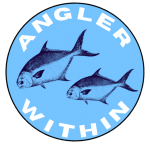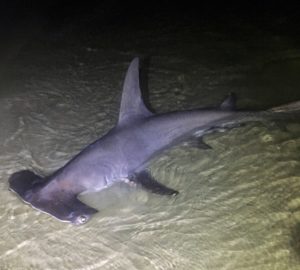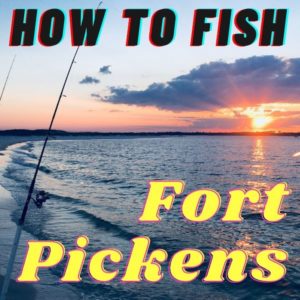anglerwithin.com is a participant in the Amazon Services LLC Associates Program, an affiliate advertising program designed to provide a means for sites to earn advertising fees by advertising and linking to amazon.com.
Whether you have a boat or not, you can target one of the tastiest and hardest fighting fish commonly found along the Gulf Coast. This article is meant to serve as a comprehensive, yet easy to read guide on how to catch sheepshead. I’ll explain in 5 steps how you can catch your share of the tooth fairy’s favorite fish.
- LEARN ABOUT SHEEPSHEAD
- LEARN WHERE TO FIND THEM
- TACKLE SELECTION
- BAIT SELECTION
- TECHNIQUES THAT WORK BEST
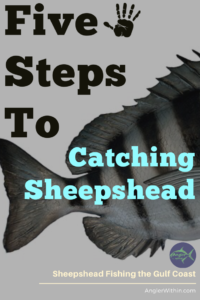

1. Sheepshead Basics
It’s all about the teeth!
Sheepshead have small but powerful mouths full of human-like teeth which they use to eat barnacles right off the side of any hard structures such as bridge pilings and piers. These teeth are one of the distinguishing characteristics between them and Black Drum, the only species they could likely be confused with.
Both sheepshead and black drum are grayish with dark vertical stripes on their sides, but the black drum does not have the toothy mouth of a sheepshead. With the aid of these tiny, strong mouths, sheepshead have mastered the art of stealing your bait. Combine that with their black stripes and you can clearly see how they got their most common nickname of “Convict Fish”.
These guys are very commonly caught in the 2 to 5 pound range, but it’s not unusual for them to get over 10 pounds, with the record being 21 pounds 4 ounces (Louisiana). Pound for pound they are powerful fighters reminiscent of a giant bluegill, but,they don’t always share the willing appetite of a bluegill. In fact, at times, they can be quite finicky about which baits they will take.
Their main hangouts include hard, jagged, line-cutting structures which makes it all the more difficult to land one after you get it hooked. This makes for quite a challenging fish to catch, which is partly what makes them so fun to target. That, and the fact that they are so tasty!
Sheepshead remind me a lot of crappie in that they have a similar panfish shape, they taste excellent and they are difficult to master. Additionally, they play second fiddle to more glamorous species, much like crappie do to the Largemouth bass.
With ever-tightening regulations on the Gulf Coast fishery, sheepshead remain a plentiful species with a generous limit, so they are great to target for table fare.
2. Where to Find Sheepshead
Before we can even get to how to catch sheepshead, we first must determine where to find them. When searching for sheepshead, it is more productive to focus your efforts in or near water 10 feet or deeper.
Generally speaking the best time to go after sheepshead is December to April, with the hottest bite being in March and April as they congregate to spawn. You can catch them year round in most gulf coast areas, but you won’t find them as stacked up and eager to feed as you do during these springtime months.
Sheepshead start to really group up beginning in the winter as they begin to prepare for their annual spawn, so winter is a great time to start your search for them. However, as summer nears, they will become more difficult to target. This is because they spread back out and also because of all the other undesirable species moving in to share the same structure.
Let’s talk about some of the best types of structure where sheepshead can be found.
How to Catch Sheepshead from Bridges
Bridges are one of the best places to find concentrations of sizable sheepshead. The fish move up and down the pylons to feed on the attached barnacles. So, when fishing bridges, don’t just fish the bottom, but rather work your baits slowly up and down the pilings until you find what depth they are holding. Sheepshead tend to be on pilings in the deeper water sections of the bridge, so that is where you should start your search.
Below are some widely known sheepshead haunts to give you an idea what to look for in your area.
- Destin Bridge (FL)
- Midway Bridge (Destin, FL)
- Tom's Bayou Bridge (Niceville, FL)
- Dauphin Island Bridge (AL)
- Perdido Pass Bridge (AL)
How to Catch Sheepshead from Jetties and Sea Walls
When fishing a Jetty from shore, a good tactic is to cast up-current and allow your bait to drift and fall over the submerged rocks. If you do this, make sure you keep the slack out of your line the best you can so you can detect the bite. You can expect to have some hangups and lost tackle with this method.
Another option is to use a cork, and suspend your bait above the rocks at whichever depth you find to be most productive that day. It can be difficult to detect bites this way, but it will certainly work, and you won’t lose as much terminal tackle.
Yet a third option is to use a VERY long rod, like a crappie pole or cane pole, to reach out and fish vertically over the underwater structure. This will help prevent as many hangups. Depending where you are fishing, this may or may not work as you may or may not be able to reach the depth they are holding that day. Some spots will have deeper water very close to shore but many will not.
If you have a boat, you can obviously use any of the same 3 tactics. Just but be very careful not to let your vessel be swept up onto the jetty rocks.
Examples:
- Perdido Pass Jetties (AL)
- Destin Jetties (FL)
Docks
Docks are also great places to find sheepshead, but not all docks are created equal. You want to focus on those close to deep water access and the older the dock the better. Older, more dilapidated docks are going to have more oysters and barnacles, which in turn means more sheepshead.

Piers
There are many piers all along the gulf coast that hold great numbers of Sheepshead. When fishing public piers, you will have to bring your “A” game, as these fish receive much fishing pressure and will be very wary. Nevertheless, these are great, accessible places to catch sheepshead.
Below are some great piers to visit for a fun day over the water. This is definitely not a comprehensive list, but rather a few of the options in the areas I am most familiar.
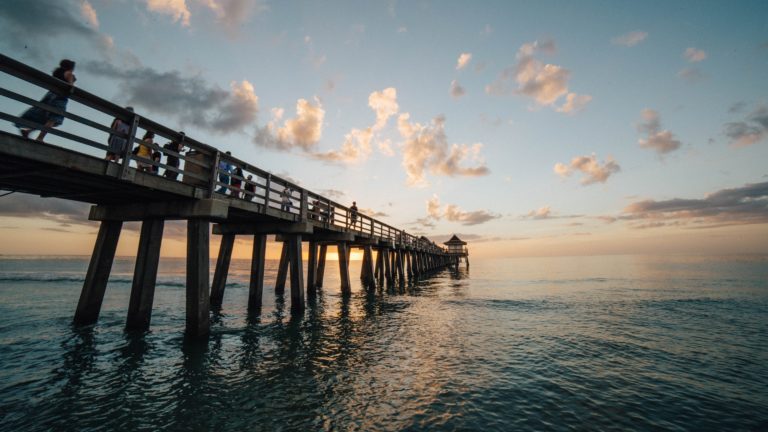
Wrecks, Oyster Bars, Artificial Reefs and Rubble Piles
Any submerged and hidden structures, out of reach from land, are going to be great places to target for boat anglers. On the right piece of structure you can stumble upon great concentrations of larger sheepshead that have not been picked over by the swarms of shore anglers.
Gas Rigs
Inshore and nearshore gas rigs are other perfect places to catch sheepshead as the fish start to stack up when the spawn nears.
- Gas Rigs of Mobile Bay (AL)
***Quick Tip***
You can take some of the specific spots I mentioned above and compare them to online maps to locate similar areas where you live. Just remember, Google Maps and Google Earth are your friends. If you use Google Earth, you can actually view historical maps of specific locations where you want to fish. This can be helpful in determining how long a structure (i.e. a dock) has actually been there. Remember, older structure is better.
3. Best Baits To Catch Sheepshead
Now that you know where to find sheepshead, we need to discuss your bait options.
Sheepshead are built to consume crustaceans, and if there is a favorite it has to be fiddler crabs. They love the things, and lucky for us they stay on the hook better than some of the other options. Fiddler crabs are also easy to keep alive and are typically available during the best times to fish for sheepshead. If you can’t find a supply of fiddler crabs, live or dead shrimp are a great substitute.
Other good options are any type of crustacean of similar size. Just don’t use fish for bait as that won’t produce the results you want. I tried to list most of the commonly used bait options below. Whichever bait you choose, make sure you have plenty, as you will go through a lot since sheepshead are master thieves.
Fiddler Crabs Are The Best Bait For Sheepshead
Fiddler crabs are widely considered to be the best bait to catch sheepshead. If the tackle shop has them, that is definitely what you want to get.
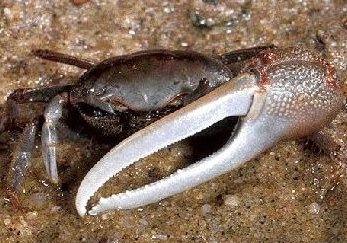
Fiddler crabs are one of the hardiest sheepshead baits and they stay on the hook the best. To hook a fiddler crab, use a #1 or 1/0 bait hook and hook the crab going in from underneath on one side or the other and come out the hard shell on top. Do so gently so as to not crush the bait. This will keep the crab alive for a while, which is preferred.
Bigger male fiddlers, which can be identified with their larger claw, are preferred over the smaller females. You should break off the large claw so as to reduce the chance of a sheepshead grabbing it and stealing your bait. If your crabs are small, it’s OK to put more than one on the same hook.
The price of fiddlers are going to vary depending on where you buy and exactly when you buy. If I were to throw out a ballpark price I’d save they should be about $4 a dozen.
Rather than purchasing fiddlers, you could instead try to catch your own, if you have the time and ambition to do so. There are lots of ways to go about catching fiddlers with the simplest being to simply chase them down and grab them with your (preferably gloved) hands.
Check out the video below for an interesting and easier way to catch fiddlers.
Shrimp
When using shrimp, the smaller the better, and live shrimp are much preferred over dead when you are trying to catch sheepshead.
It’s often a problem that the shrimp available in the bait shops are too big. If you can find shrimp 1.5 inches long then use the whole shrimp and run the hook through it’s tail and out the underside of the body, thereby burying the shank of the hook. However, if the shrimp is larger than about 1.5 inches, break it into 2 or more pieces and rig the pieces it a similar way. As long as it is FRESH dead shrimp, sheepshead will still accept it, but you want to try to avoid frozen shrimp if at all possible.
An added bonus when using shrimp as bait is that you have a great chance at also catching redfish mixed in. So, if you want to avoid redfish for some strange reason, then don’t use shrimp.
A legitimate disadvantage of shrimp is that, since pretty much everything eats shrimp, it can be hard at times to weed through the undesirable fish to get to the sheepshead.
Sand Fleas (Mole Crabs)
Probably one of the top 3 baits to use to catch sheepshead has to be sand fleas. At certain times of the year they are plentiful along the edge of the surf. Just use a sand flea rake and scoop them out of the swash zone after you have identified a stretch of beach holding them. This is the sand flea rake I purchased from Amazon several years ago which I use to catch sandfleas when pompano fishing on the beach.
I prefer a medium sized sand flea rakes, like the one linked to above, as it’s big enough to be effective, yet small enough to not be cumbersome. It is really easy to catch fleas once you locate a colony along the waters edge.
Here is a good video explaining how to locate and catch them.
Hermit Crabs
I have never personally used hermit crabs as bait, but I understand that they are a great bait to use to catch sheepshead. All you need is a heavy chunk of rock or a hammer to break them out of their shells. Run your hook through them 2 or 3 times and try to completely cover your hook.
Barnacles
In addition to knocking barnacles into the water as chum, you can actually use them as bait. Just break them open and thread them onto the hook as best you can. Sheepies love the things.
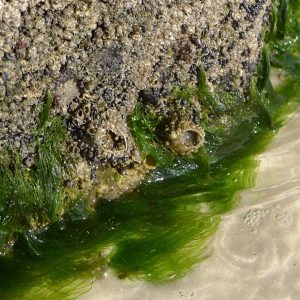
Other Crabs
There are too many crab options to bother listing them all. I think pretty much any small crab, local to your neck of the woods, should work great for catching sheepshead. Mud crabs, oyster crabs and any crab that’s a similar size as a fiddler crab should be just fine. Be careful not to use a juvenile version of a protected species.
Mussels, Clams and Oysters
These are all good baits for sheepshead as well. but they are easier to steal off the hook so they are not as good as crabs or shrimp. Also, beware that oysters can have regulations and seasons applied to them so they may not be legal to collect from the wild in your area during certain times.
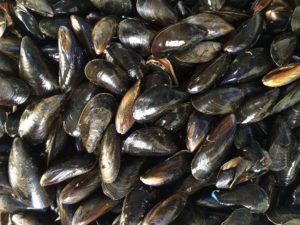
***Quick Tip***
Don’t forget to bring your own bucket so you don’t have to buy one at the bait shop. I have made that mistake several times over the years. Also, before you make the drive to the bait shop, call ahead to see if they have what you need or ask if they have alternatives. The last thing you want to do is to be driving around at 5:30 in the morning in different directions looking for bait.
4. Tackle Selection For Sheepshead
Since sheepshead can be rather finicky, you will want to limit the size of your tackle. Bigger is not better here as you will mostly be catching fish in the 2-5 pound range that have good eyesight.
Rod
There are tons of rods that will work well for catching sheepshead, but the best rods are going to be sensitive and have a fast action so that you can feel bites better. So, graphite is a far better option than fiberglass.
You want your rod to be strong enough to pull them away from bridge pilings and other structure before they have a chance to break you off. But, don’t go too strong or you miss out on some of the sporting fun.
If you are going to be fishing around rubble piles then you can get away with lighter gear, which makes it much more fun. I would say a medium power rod in the 6 to 7 foot range is a great balance between being sporting, yet strong enough to pull them away from structure. If you will be fishing primarily around docks and bridges, you might want to go with a medium-heavy.
Reel
Reel selection is not as important with sheepshead fishing. Any 2500-5000 sized reel should be perfect. Or, if you already own some bass fishing gear, that will work great as well.
A stud sheepshead will get over 10 pounds, so if you are fishing around vertical structure such as bridge pilings you might want something with some decent drag to get the fish out before he wraps you up. But, again, most bass reels should be fine if you crank the drag down.
Main Line Options For Sheepshead
You have several options for your main line and they all can work well. There are advantages and disadvantages to each, of course, which I have listed below.
I personally prefer braid for it’s added sensitivity, but mono and flouro certainly have their merits as well.
You are going to have break-offs if you do much sheepshead fishing, and mono is easy to work with and it’s cheap. Flourocarbon works better than mono in clear water, and also when you are fishing around barnacle-laden pilings. It is more invisible to the fish, and the added abrasion resistance helps reduce cutoffs on jagged structures.
Straight Monofilament
12-20 pound mono is a great size
Mono is the cheapest option
Mono is easy to work with
Better knots
Generally very user friendly
Good in clear water
Flourocarbon
12-20 pound is best
Flouro is more expensive than mono
More abrasion resistant than mono
Most invisible to the fish
Fewer break-offs than mono
Great for leader material
Braid
10-20 pound braid is best
Braid is expensive
Far more sensitive to the bite
Strongest option to pull fish away from structure quickly
More likely to cut your finger when fishing
Better hook sets (no stretch)
Weights
You need to have an assortment of weights on hand so that you can adapt to varying currents and depths.
Go with the lightest weights that you can get away with. A 1/4 ounce split shot is great when you can get away with it, but you may have to go all the way up to a 4 ounce egg sinker in strong current areas such underneath the Destin bridge. It’s best to stock up on split shots along with some 1/2 to 4 ounce egg sinkers. You can add multiple weights to get to the total weight you need.
Leader
Leaders should be shorter than you might use with other species, so you can better feel the light bites.
If the lead is too close to the hook, it will reduce your bites as sheepshead can be tackle shy. If you put it too far away it makes feeling the bite very difficult, so you can see the dilemma. About 1 to 2 feet long is a good length, and the leaders need to be made of fairly light mono or flourocarbon.
Sheepshead are wary and finicky, especially if you are fishing from a public pier where they receive tremendous pressure. So you want to steer away from really heavy line. Anywhere from 12 to 25 pound mono or flourocarbon is a good choice. Flourocarbon is better, as it is almost invisible to the fish, and it has added abrasion resistance.
Tie your leader to the mainline with a double uni knot, and if using clamp on weights, put it right below the knot. You can also use a carolina rig, with a swivel connecting your leader to your main line, with the weight above the swivel. I prefer to avoid swivels when possible.
Hooks
Your hook selection will be one of the most important aspects of your entire setup to catch sheepshead. It’s important that it be small, yet very strong. A size 1/0 or #1 extra strong bait or “J” hook works great.
Normally, circle hooks are great for most species, but they don’t work as well for sheepshead, as you need to be able to set the hook in a mouth teeming with teeth. You also do not want a light wire hook, as sheepshead can literally bite them in half. If you think about it, they eat barnacles off of concrete pilings all day, so a thin hook is no match for their powerful bite.
Another great option, if you are in a state that allows it, is a #8 or #10 3x strong treble hook. Trebles work well when fishing with shrimp. You could also use a jig head, as long as the hook is fairly small (#1 or 1/0 sized).
Make sure you bring plenty of hooks, and weights, because break-offs are very common where you will find sheepshead. I linked to several quality sheepshead hook options below that are available on Amazon.
5. Techniques to Catch Sheepshead
The Bite
Sheepshead are very light biters, so you will have to really pay attention when fishing for them, or you will most certainly lose your bait. They don’t typically take the bait and run like many other fish do, but rather they suck the bait in and crush it, and it is because of this that you oftentimes never feel a bite.
As already discussed, a sensitive graphite rod, paired with braid, will help with light bites, as does being diligent with keeping slack out of the line. Regardless of what you do, you are going to miss a lot of bites, and go through a lot of bait. Don’t let that frustrate you, since that’s just part of it when you go after “Convicts”, as they are master thieves.
Tactics
As with most fishing, moving water is always best, but not really necessary to catch sheepshead. When the water is moving, be sure to fish behind the structure in the eddies that get created. That is where you will most likely find them.
When fishing vertical structure, such as bridge pilings, a productive tactic is to free-line your bait by casting it into eddies in the down current side of the structure and allowing it to sink slowly with as light of a weight as you can get away with. You do need to use a heavy enough weight to keep the bait really close to the structure, but no more than necessary.
Sheepshead generally will be facing structure, moving up and down in the water column as they eat on the attached barnacles. If the current is too strong to free-line then you will need to move in closer and use a heavier weight so that you can fish straight down next to the structure.
When fishing rock piles or oyster bars use as light of a weight as you can and still get the bait down to where the fish are. If you have moving water, cast your bait up current and allow it to slowly drift and fall over the submerged structure. Once you are past the structure, reel in and repeat the process over and over. If you don’t get bites within 10 minutes you need to move because you aren’t in a good spot.
Setting The Hook
When setting the hook, don’t set it right away or you will many times yank the hook out of his mouth. Give him just a split second to ensure the fish has it in his mouth. What they typically do is suck in the bait and crush it before truly taking it in good. So, as hard as it is, give it just a split second after you feel the initial bite. But don’t wait too long or he will chew the bait off and spit the hook. It’s a fine line that must be learned.
Sheepshead fishing is not like bass fishing where you sometimes need to drop your rod tip before driving the hook home. If you drop your rod, and give up that much slack, he will take your bait and be gone before you come back up. Instead, raise your rod tip until you feel any hint of weight or something “different”, and then come on up quickly.
Chumming For Sheepshead
Chumming can oftentimes fire up a slow bite, and is a great tactic to improve your odds at filling the cooler. There are several good ways to go about it. One of the best is to simply crush barnacles off any bridge pilings you may be fishing beside. Many anglers keep a straightened hoe, shovel, or similar long handle tool in their boats to knock off small pieces to fire up the sheepshead bite.
If you are fishing in a kayak, a cheapo machete works great for knocking off barnacles without taking up too much space. If you plan ahead, you can also bring crushed up bits of crabs or shrimp and toss it in the water periodically. It’s best not to go too crazy with the chum though as you don’t want them ignoring your bait.
Other Stuff
Regulations
Regardless of the regulations, it’s recommended that when you catch sheepshead, you only keep those 15 inches or larger. That is a good size to get a pretty nice filet. This isn’t a fish that is heavily regulated in most states, YET. So, let’s try to keep it that way, by only taking as much as we need.
Links to State Saltwater Regulations
- Alabama Department of Conservation and Natural ResourcesOpens in a new tab
- Florida Fish and Wildlife Conservation CommissionOpens in a new tab
- Louisiana Wildlife and FisheriesOpens in a new tab
- Mississippi Department of Marine ResourcesOpens in a new tab
- Texas Parks and WildlifeOpens in a new tab
- South Carolina Department of Natural ResourcesOpens in a new tab
- Georgia Sport Fishing RegulationsOpens in a new tab
- North Carolina Environmental Quality - Fishing RegulationsOpens in a new tab
Cleaning
Sheepshead taste great, but they are more of a pain to clean than most other species, partly due to their very tough and sharp spines. If you use a proven cleaning technique, you won’t have any problems. Make certain you remove any dark red bloodline, so as to improve the taste. The Youtube video below shows good technique for cleaning a sheepshead.
Cooking
Sheepshead make for a good firm white filet that tastes great. It’s a fish that lends itself to being cooked all sorts of ways, with my favorites being blackened or fried. It’s flavor even allows it to be successfully substituted for crab meat in recipes. Just remember to cut out any red pieces from the filets before freezing or cooking it.
Conclusion
If I were to try to sum up a foolproof way on how to catch sheepshead, it would be the following. Get yourself some fiddler crabs, and find some OLD, barnacle encrusted bridge pilings close to the ocean, in approximately 10 feet of water. Drive your boat, or kayak, up next to the pilings and crush some barnacles into the water. Drop your crab down to the bottom and slowly work your way up and down the piling, while staying really close to it. If there is moving water around the pylon, you want to be on the down current side. Commit about 10 minutes to a piling, after you have crushed the barnacles, as the fish may need some time to settle back down after the disturbance. If you don’t get bit, it’s time to move to another set of pylons. Do this in March and April, and you will surely find success in short order.
After you catch your first sheepshead, don’t forget to handle him carefully, as the sharp dorsal spines on top and the sharp gill plates will mess you up. Also, do yourself a favor and carefully pull those lips back, and check out the gnarley teeth, as they are truly something to behold. As the Twitter post above says, “nature is scary”.
Now, go capture yourself some “convicts”!
Augustus Clay
If you like this article, you might like some of my other “how to” articles: How To Catch Pompano, How To Catch Whiting and How To Catch Spanish Mackerel.

